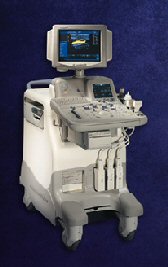Medical Ultrasound Imaging
Sunday, 19 May 2024
'Spectral Doppler' p2 Searchterm 'Spectral Doppler' found in 25 articles 1 term [ • ] - 15 definitions [• ] - 9 booleans [• ]Result Pages : •
An image artifact is any image attribute, which is not present in the original imaged object. An image artifact is sometime the result of an improper operation of the imager, and in other times a consequence of natural processes or properties of the human body. Artifacts in diagnostic ultrasound are a reflection or an echo, which appears on the display and represents the real anatomical structure not correctly. An artifact can be a false, multiple or misleading information introduced by the imaging system or by interaction of ultrasound with the adjacent tissue. Artifacts in ultrasound can be classified as to their source like e.g.:
•
physiologic (motion, different sound velocities, acoustical impedances of tissue);
•
hardware (dimension of the ultrasound beam and the transducer array);
•
Image artifacts can occur in each medical ultrasound. Then an interpretation of the image is complicated and can eliminate the structural information of objects looking for. See also Ultrasound Imaging Procedures. •
Doppler ultrasound is a medical imaging technique for calculating the relative velocity between two points by measuring the frequency shift of a sound wave transmitted from one point to the other, based on the Doppler effect. Continuous or pulsed Doppler is frequently used to examine cardiovascular blood flow. The combination of routine 2D-mode and Doppler ultrasound allows a complete evaluation of the heart's anatomy and function (including the fetal heart). See also Doppler Fluximetry in Pregnancy. Doppler ultrasound depends on the fact that if a moving object reflects the ultrasound waves, the echo frequencies are changed. A higher frequency is created if the object is moving toward the probe//transducer and a lower frequency if it is moving away from it. How much the frequency is changed depends upon how fast the object is moving. Doppler ultrasound shows the different rates of blood flow in different colors on a monitor in real time. The major Doppler parameters are the peak systolic velocity and the end-diastolic velocity. The peak systolic velocity ratio compensates the variability between different patients and instrumentations. Different Doppler and duplex techniques: Further Reading: News & More:
•
Duplex ultrasonography (duplex scan) consists of two ultrasound modalities to study blood flow and the perivascular tissue. This includes B-mode / gray scale imaging used in combination with spectral Doppler / pulsed-wave Doppler. The real-time visualization of the vessels and tissue by the B-mode component improves the PW Doppler positioning and the direction of blood flow can be inferred. The angle between the direction of the PW Doppler signal and the estimated direction of blood flow can be measured. Duplex techniques are available on phased array, linear array, and mechanical scanners. A phased array probe is able to create nearly simultaneous images and flow information. A linear array transducer can also do this if the Doppler probe is attached separately to one end of the scanhead. A mechanical transducer freeze the image; the crystals must be static to produce a Doppler image. The first two transducers are therefore the best choice for Duplex. See also Compound B-Mode, and Duplex Scanner. Further Reading: News & More:
•
Harmonic imaging relies on detection of harmonics of the transmitted
frequency produced by bubble oscillation. This method is widely available on ultrasound scanners and uses the same array transducers as conventional imaging. A major limitation of the use of ultrasound contrast agents is the problem that signals from the microbubbles are mixed with those from tissue. Echoes from solid tissue and red blood cells are suppressed by harmonic imaging. In harmonic mode, the system transmits at one frequency, but is tuned to receive echoes preferentially at double that frequency, and the second harmonic echoes from the place of the bubble. Typically, the transmit frequency lies between 1.5 and 3 MHz and the receive frequency is selected by means of a bandpass filter whose center frequency lies between 3 and 6 MHz. Color Doppler and real-time harmonic spectral Doppler modes have also been implemented and show a level of tissue motion suppression not available in conventional modes. See also Harmonic B-Mode Imaging, and Harmonic Power Doppler. Further Reading: Basics:
News & More:
•  From GE Healthcare.;
From GE Healthcare.;Versatile High Performance System 'The LOGIQ 5 Expert ultrasound system delivers the premium performance advantage of TruScan architecture in a versatile high performance package. Advanced capabilities for outstanding clinical performance are available with the efficiency and productivity needed to meet clinical demands.'
Device Information and Specification
APPLICATIONS
Abdominal, cardiac, musculoskeletal, neonatal, OB/GYN, small parts, transcranial, urologic, vascular
CONFIGURATION
Normal system
B-mode, M-mode, anatomic M-mode creation and adjustment, triplex, 3D ultrasound, pulsed wave Doppler, continuous wave Doppler, power Doppler, color Doppler, spectral Doppler
IMAGING OPTIONS
OPTIONAL PACKAGE
STORAGE, CONNECTIVITY, OS
On-board patient, image and reporting archive, HDD, CD-ROM disk burner included, PCMCIA, USB, Windows-based OS
DATA PROCESSING
H*W*D m (inch.)
1.45 * 0.52 * 0.99 (57 * 20 * 39)
WEIGHT
180 kg (397 lbs.)
POWER CONSUMPTION
less than 1.5 KVA
Result Pages : |
Medical-Ultrasound-Imaging.com
former US-TIP.com
Member of SoftWays' Medical Imaging Group - MR-TIP • Radiology TIP • Medical-Ultrasound-Imaging
Copyright © 2008 - 2024 SoftWays. All rights reserved.
Terms of Use | Privacy Policy | Advertise With Us
former US-TIP.com
Member of SoftWays' Medical Imaging Group - MR-TIP • Radiology TIP • Medical-Ultrasound-Imaging
Copyright © 2008 - 2024 SoftWays. All rights reserved.
Terms of Use | Privacy Policy | Advertise With Us
[last update: 2023-11-06 01:42:00]




